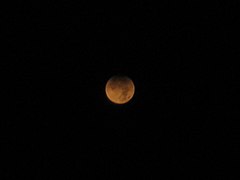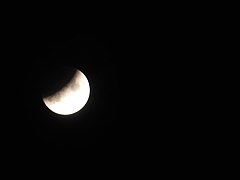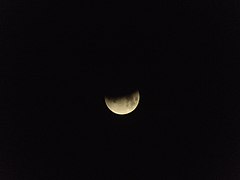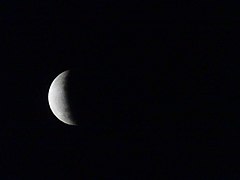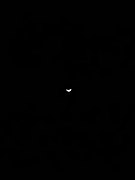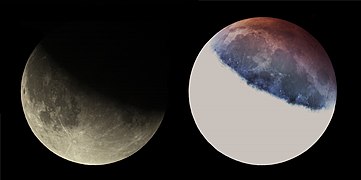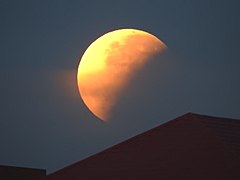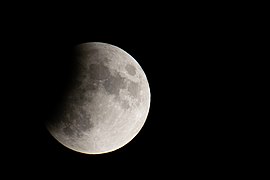
A total lunar eclipse took place on 3 March 2007, the first of two eclipses in 2007. The Moon entered the penumbral shadow at 20:18 UTC, and the umbral shadow at 21:30 UTC. The total phase lasted between 22:44 UTC and 23:58 UTC with a distinctive brick-red shade. The Moon left the umbra shadow at 01:11 UTC and left the penumbra shadow at 02:24 UTC 2007-03-04. The second lunar eclipse of 2007 occurred on 28 August.

A total lunar eclipse occurred on February 20 and February 21, 2008. It was visible in the eastern evening sky on February 20 for all of North and South America, and on February 21 in the predawn western sky from most of Africa and Europe. Greatest Eclipse occurring on Thursday, February 21, 2008, at 03:26:03 UTC, totality lasting 49 minutes and 45.6 seconds.

A total lunar eclipse occurred from 5:27 to 11:06 UTC on 21 December 2010, coinciding with the date of the Winter solstice in the Northern Hemisphere and Summer solstice in the Southern Hemisphere. It was visible in its entirety as a total lunar eclipse in North and South America, Iceland, Ireland, Britain and northern Scandinavia.

A total lunar eclipse took place on 15 June 2011. It was the first of two such eclipses in 2011. The second occurred on 10 December 2011. While the visual effect of a total eclipse is variable, the Moon may have been stained a deep orange or red colour at maximum eclipse.

A partial lunar eclipse was visible on 31 December 2009. It was the last and largest of four minor lunar eclipses in 2009. This lunar eclipse was also notable, because it occurred during a blue moon and was near perigee. The next eclipse on New Year's Eve and blue moon will occur on 31 December 2028.

A partial lunar eclipse occurred on 26 June 2010, the first of two lunar eclipses in 2010. At maximum eclipse, 53.68% of the Moon was covered by the Earth's shadow.

A partial lunar eclipse took place on Thursday 5 July 2001, the second of three lunar eclipses in 2001. The Earth's shadow on the moon was clearly visible in this eclipse, with 49.614% of the Moon in shadow; the partial eclipse lasted for 2 hours, 40 minutes and 0.5 seconds. Occurring only 3.9 days before apogee, the Moon’s apparent diameter was 5.021% smaller than average.

A partial lunar eclipse took place at the Moon's descending node on the evening of 7 August and the morning pre-dawn on 8 August 2017, the second of two lunar eclipses in 2017. The Moon was only slightly covered by the Earth's umbral shadow at maximum eclipse. The Moon's apparent diameter was smaller because the eclipse occurred only 5 days after apogee.

A total lunar eclipse will take place between Monday and Tuesday, June 25-26, 2029. A central total eclipse lasting 1 hour and 41 minutes 53 seconds will plunge the full Moon into deep darkness, as it passes right through the centre of the Earth's umbral shadow. While the visual effect of a total eclipse is variable, the Moon may be stained a deep orange or red color at maximum eclipse. It will be able to be seen from most of the Americas, Western Europe and Africa. The partial eclipse will last for 3 hours and 39 minutes 32 seconds in total.

A total lunar eclipse occurred at the Moon's descending node on 27 July 2018. The Moon passed through the center of Earth's shadow in what was the first central lunar eclipse since 15 June 2011. It was also the second total lunar eclipse in 2018, after the one on 31 January. It was the longest total lunar eclipse of the 21st century, but not the longest in the 3rd millennium. The longest total lunar eclipse of the 3rd millennium will occur on May 12, 2264, lasting 106 minutes and 13.2 seconds, which will be the longest total lunar eclipse since 2000, and the longest one until 3107.
A partial lunar eclipse took place on Saturday, June 25, 1983, the first of two lunar eclipses in 1983 with an umbral eclipse magnitude of 0.33479. A partial lunar eclipse happens when the Earth moves between the Sun and the Full Moon, but they are not precisely aligned. Only part of the Moon's visible surface moves into the dark part of the Earth's shadow. A partial lunar eclipse occurs when the Earth moves between the Sun and Moon but the three celestial bodies do not form a straight line in space. When that happens, a small part of the Moon's surface is covered by the darkest, central part of the Earth's shadow, called the umbra. The rest of the Moon is covered by the outer part of the Earth's shadow called the penumbra. The Earth's shadow on the moon was clearly visible in this eclipse, with 33% of the Moon in shadow; the partial eclipse lasted for 2 hours and 15 minutes.
A penumbral lunar eclipse took place on Thursday, March 3, 1988, the first of two lunar eclipses in 1988, the second being on August 27, 1988. Earlier sources compute this as a 0.3% partial eclipse lasting under 14 minutes, and newest calculations list it as a penumbral eclipse that never enters the umbral shadow. In a rare total penumbral eclipse, the entire Moon was partially shaded by the Earth, and the shading across the Moon should have been quite visible at maximum eclipse. The penumbral phase lasted for 4 hours, 53 minutes and 50.6 seconds in all, though for most of it, the eclipse was extremely difficult or impossible to see. The Moon was 2.2 days after apogee, making it 6.1% smaller than average.
A penumbral lunar eclipse took place on Tuesday, January 20, 1981, the first of two lunar eclipses in 1981. In a rare total penumbral eclipse, the entire Moon was partially shaded by the Earth, and the shading across the Moon should have been quite visible at maximum eclipse. The penumbral phase lasted for 4 hours and 24 minutes in all, though for most of it, the eclipse was extremely difficult or impossible to see. The moon's apparent diameter was larger because the eclipse occurred 5.2 days after perigee.

A partial lunar eclipse occurred on 19 November 2021. The eclipse occurred towards a micromoon. This was the longest partial lunar eclipse since 18 February 1440, and the longest until 8 February, 2669; however, many eclipses, including the November 2022 lunar eclipse, have a longer period of umbral contact at next to 3 hours 40 minutes. It was often referred to as a "Beaver Blood Moon" although not technically fulfilling the criteria for a true blood moon (totality).

A partial lunar eclipse will take place on Friday 28 August 2026. The moon will be almost be inside the umbra, but not quite be contained within the umbral shadow at greatest eclipse.
A total lunar eclipse took place on Saturday, September 16, 1978, the second of two total lunar eclipses in 1978. The Moon was plunged into darkness for 1 hour, 18 minutes and 39 seconds, in a deep total eclipse which saw the Moon 32.683% of its diameter inside the Earth's umbral shadow. The visual effect of this depends on the state of the Earth's atmosphere, but the Moon may have been stained a deep red colour. The partial eclipse lasted for 3 hours, 27 minutes and 11.6 seconds in total.

A partial lunar eclipse took place on Monday, June 14, 1965. At maximum eclipse, a small bite out of the Moon should have been visible. The eclipse lasted for 1 hour and 40 minutes, with just 18% of the Moon in shadow at maximum.
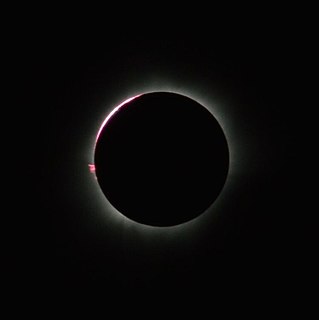
A total solar eclipse took place at the Moon's descending node of the orbit on March 8–9, 2016. If viewed from east of the International Date Line, the eclipse took place on March 8 (Tuesday) and elsewhere on March 9 (Wednesday). A total solar eclipse occurs when the Moon's apparent diameter is larger than the Sun's and the apparent path of the Sun and Moon intersect, blocking all direct sunlight and turning daylight into darkness; the Sun appears to be black with a halo around it. Totality occurs in a narrow path across Earth's surface, with the partial solar eclipse visible over a surrounding region thousands of kilometres wide. The eclipse of March 8–9, 2016 had a magnitude of 1.0450 visible across an area of Pacific Ocean, which started in the Indian Ocean, and ended in the northern Pacific Ocean.

A total lunar eclipse will occur on Wednesday, June 9, 2123, with maximum eclipse at 05:06 UTC. A dramatic total eclipse lasting 106 minutes and 6 seconds will plunge the full Moon into deep darkness, as it passes right through the centre of the Earth's umbral shadow. While the visual effect of a total eclipse is variable, the Moon may be stained a deep orange or red colour at maximum eclipse. This will be a great spectacle for everyone who sees it. The partial eclipse will last for 3 hours and 56 minutes in total. The penumbral eclipse lasts for 6 hours and 14 minutes. Maximum eclipse is at 05:06:28 UT. This will be the longest Total Lunar Eclipse since 16 July 2000, and the longest one until 12 May 2264 and 27 July 3107, though the eclipse on June 19, 2141 will be nearly identical in all aspects. This will also be the longest of the 22nd century and the second longest of the 3rd millennium. The eclipse on June 19, 2141 will be the second longest of the 22nd century and the third longest of the third millennium.

A partial lunar eclipse will take place on August 7, 2055. It will last 3 hours, 23 minutes, and 23 seconds. It will be the last of the first set of partial eclipses in Lunar Saros 139.




